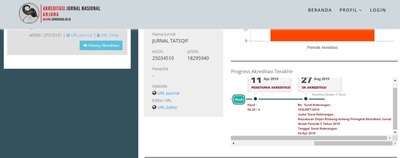Mareta, Mira (2021) Religious education and adolescent religiosity (part 1: urban and rural madrasah aliyah characteristics in Lombok Island). Jurnal Tatqif, 19 (2). pp. 192-215. ISSN e-ISSN: 2503-4510; P-ISSN:1829-2940
|
Text (Article)
religions (mira Mareta).pdf - Published Version Available under License Creative Commons Attribution Non-commercial No Derivatives. Download (439kB) |
||
![[img]](http://repository.uinmataram.ac.id/1604/3.hassmallThumbnailVersion/Akreditasi%20Jurnal%20Tatsqif.jpeg)
|
Image (Journal Akreditation)
Akreditasi Jurnal Tatsqif.jpeg - Published Version Available under License Creative Commons Attribution Non-commercial No Derivatives. Download (59kB) | Preview |
|
|
Text (Plagiarism Check (turnitin))
Religious Education And Adolescent Religiosity (Part 1_ Urban And Rural Madrasah Aliyah Characteristics In Lombok Island).pdf - Published Version Available under License Creative Commons Attribution Non-commercial No Derivatives. Download (3MB) |
Abstract
ENGLISH The current social circumstances at the spiritual level have brought an enormous influence on the establishment of religious behavior in adolescent students, both in the level of belief, practice, and religious experience. Religious education in the madrasah environment has a strategic position in building students' religious behavior. This study aims to explain why the rural and urban madrasah environment context is essential to observe the role of religious education, especially Islamic education, in building students' religious behavior in Lombok island. Then it sorts out the madrasahs characteristics or uniqueness from the two different regions, rural and urban. This research is qualitative psychological research with ecological contextual theory as the theoretical framework. The data analysis method is descriptive and holistic by employing three flows of interacting activities, e.g., reducing data, presenting it, and drawing conclusions. Data was obtained through documentation, observation, and in-depth interviews. This research was conducted in six madrasahs, i.e., two Madrasah Aliyah located in the downtown, and four Madrasah Aliyah, which geographically represent the category of the rural madrasah. The research results indicate that the spiritual development of the students cannot be separated from the religious education context in their environment. In urban areas context, the madrasah environment has formal systemic characteristics, is supported by strong management and leadership, maintains the madrasah stability and conduciveness by implementing a power strategy through a set of rules and code of conduct. Meanwhile, madrasas in rural areas have flexible, dynamic, and adaptive characteristics, in which education takes into account cultural aspects and values applied in the community.
| Item Type: | Article |
|---|---|
| Uncontrolled Keywords: | religious education, religious behavior, youth religiosity, rural madrasah, urban madrasah |
| Subjects: | 13 EDUCATION > 1301 Education Systems > 130106 Secondary Education 13 EDUCATION > 1302 Curriculum and Pedagogy > 130211 Religion Curriculum and Pedagogy 17 PSYCHOLOGY AND COGNITIVE SCIENCES > 1701 Psychology > 170103 Educational Psychology 22 PHILOSOPHY AND RELIGIOUS STUDIES > 2203 Philosophy > 220315 Philosophy of Religion |
| Divisions: | Fakultas Dakwah dan Ilmu Komunikasi > Jurusan Bimbingan Konseling Islam |
| Depositing User: | Raden . Jie |
| Date Deposited: | 08 Aug 2022 03:08 |
| Last Modified: | 14 Feb 2023 01:57 |
| URI: | http://repository.uinmataram.ac.id/id/eprint/1604 |
Actions (login required)
 |
View Item |

